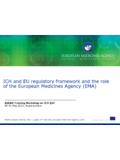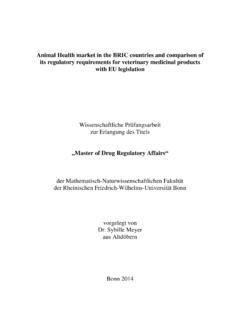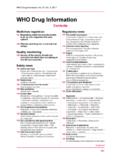Transcription of Biosimilars in the EU - European Medicines Agency
1 Information guide for healthcare professionalsBiosimilars in the EUPrepared jointly by the European Medicines Agency and the European CommissionTable of contentsForeword 2 Summary 3 Biological Medicines : overview 5 Key features of biological Medicines 5 Biosimilar Medicines : definition and features 8 Why Biosimilars are not considered generic Medicines 10 Development and approval of Biosimilars in the EU 12A robust regulatory framework for Biosimilars 12 Process for approval of Biosimilars in the EU 12 Data requirements for approval.
2 A scientifically tailored package 12 Immunogenicity 20 Extrapolation 22 Safety of Biosimilars 24 General considerations on safety for Biosimilars 24 Safety monitoring for all biological Medicines , including Biosimilars 24 Traceability: importance of identifying biological Medicines by tradename and batch number 25 How healthcare professionals can help improve pharmacovigilance for biological Medicines 26 Data included in the prescribing information and EMA assessment reports for Biosimilars 27 Data for prescribing: summary of product characteristics (SmPC) 27 Data on biosimilarity: published in the assessment report 27 Implications of the availability of Biosimilars 28 Interchangeability, switching and substitution.
3 EMA and Member States responsibilities 29 Definitions 29 EMA and Member States responsibilities 29 Communicating with patients on Biosimilars 30EU contribution to the regulation of Biosimilars worldwide 31 References 32 Abbreviations 33 Glossary 34 Forewordby Prof.
4 Guido Rasi EMA Executive DirectorBiological Medicines , often produced by cutting-edge biotechnology, have transformed the outlook for patients with many chronic and often disabling conditions. An increasing number of biological Medicines are Biosimilars - Medicines highly similar in all essential aspects to an already approved biological EU has pioneered the regulation of biosimilar Medicines by establishing a solid framework for their approval and by shaping biosimilar development globally. Since the EU approved the first biosimilar in 2006, healthcare professionals have gained increasing experience with their use.
5 Today, Biosimilars are an integral part of the effective biological therapies available in the EU, supported by adequate safeguards protecting patient healthcare professionals are at the forefront of patients care, it is vital that they have access to reliable information on these Medicines : what they are and what scientific principles support their clinical development, approval and safety monitoring. This guide has therefore been prepared with the important objective of providing healthcare professionals with reference information on both the science and regulation underpinning the use of Biosimilars .
6 ContributorsThis guide has been prepared by the European Medicines Agency in collaboration with the European Commission and scientific experts from EU Member needs and feedback from EU healthcare professionals organisations have been sought throughout the preparation of this Summary Since the EU approved the first biosimilar medicine ( biosimilar ) in 2006, the EU has pioneered the regulation of Biosimilars . Over the past 10 years, the EU has approved the highest number of Biosimilars worldwide, amassing considerable experience of their use and safety. The evidence acquired over 10 years of clinical experience shows that Biosimilars approved through EMA can be used as safely and effectively in all their approved indications as other biological Medicines .
7 A biosimilar is a biological medicine highly similar to another biological medicine already approved in the EU (the so-called reference medicine ). Because Biosimilars are made in living organisms there may be some minor differences from the reference medicine . These minor differences are not clinically meaningful, no differences are expected in safety and efficacy. Natural variability is inherent to all biological Medicines and strict controls are always in place to ensure that it does not affect the way the medicine works or its safety. Biosimilars are approved according to the same standards of pharmaceutical quality, safety and efficacy that apply to all biological Medicines approved in the EU.
8 The aim of biosimilar development is to demonstrate biosimilarity - high similarity in terms of structure, biological activity and efficacy, safety and immunogenicity profile. By demonstrating biosimilarity, a biosimilar can rely on the safety and efficacy experience gained with the reference medicine . This avoids unnecessary repetition of clinical trials already carried out with the reference medicine . Demonstration of biosimilarity relies on comprehensive comparability studies with the reference medicine . If a biosimilar is highly similar to a reference medicine , and has comparable safety and efficacy in one therapeutic indication, safety and efficacy data may be extrapolated to other indications already approved for the reference medicine .
9 Extrapolation needs to be supported by all the scientific evidence generated in comparability studies (quality, non-clinical and clinical). Extrapolation is not a new concept but a well-established scientific principle used routinely when biological Medicines with several approved indications undergo major changes to their manufacturing process ( to introduce a new formulation). In most of these cases, clinical trials are not repeated for all indications and changes are approved based on quality and in vitro comparability studies. All indications of biological Medicines (including Biosimilars ) have been granted based on sound scientific evidence.
10 Safety of Biosimilars is monitored through pharmacovigilance activities, in the same way as for any other medicine . There is no specific safety requirement applicable only to Biosimilars because of their different development route. 3 Over the last 10 years, the EU monitoring system for safety concerns has not identified any relevant difference in the nature, severity or frequency of adverse effects between Biosimilars and their reference Medicines .

















